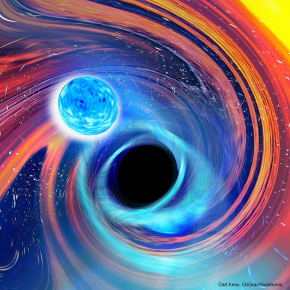Gravitational wave signal reshuffles maps of celestial object masses
The LIGO Virgo KAGRA collaboration has detected a gravitational signal from the merger of a neutron star with an unexpectedly massive object. The mass of this celestial body, which has been accurately estimated, would make it a strangely light black hole or, much less likely, an extremely massive neutron star.
Electromagnetic observations of celestial objects in the galaxy suggested that there could be no neutron stars or black holes with masses between 3 and 5 solar masses. Scientists call this the "mass gap". Gravitational event GW230529, the analysis of which has just been published by the LIGO Virgo KAGRA collaboration, shatters this idea by showing that one of the celestial bodies involved in the merger had a mass between 2.5 and 4.5 solar masses, with a probability of 90% (the second object having a mass between 1.2 and 2.0 solar masses).
At this stage, the most likely interpretation is that of a light black hole, but the data doesn't rule out the possibility of a heavy neutron star either. Mergers of a black hole and a neutron star of such close masses are also interesting, as they have a high probability of having an observable electromagnetic counterpart. However, the event was captured when only the LIGO interferometer at Livingston (USA) was taking data from the collaboration's four interferometers. The location of the event was therefore too imprecise for it to be retrieved by telescopes.
This type of merger, which is more complicated to detect, was made possible by the integration of new, dedicated functions in the collaboration's three detection algorithms (GstLAL, MBTA and PyCBC) for run O4. The MBTA pipeline has benefited from contributions from IPHC, LAPP and IP2I, while the PyCBC pipeline has benefited from contributions from IJCLab.
Access the pre-publication
Go to the full press release of the LIGO Virgo KAGRA collaboration
Go to Observatoire de la côte d'Azur (OCA) press release
